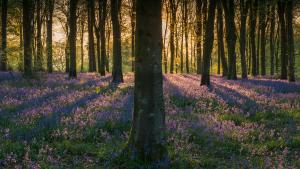
Disappointed by the lack of emotional connection to a series of photographs Huw Alban, a Dorset "artist using photography", developed his purpose in pursuing photography. He investigated what it was that made him stop after viewing an image to identify what encouraged him to look harder at it. If he could hear the sounds of the image or could see the quality of the image that made him look that little bit harder he could understand the message that the photographer was attempting to transmit. He needed to achieve some kind of emotional reaction to the image. Having realised what it was he developed an approach that allowed him to include such a quality in his own images, particularly in landscape images. Mood and process are key components in his approach.
His prime activity was to take time to contemplate and absorb what is going on all around him, to get the feel of the location. He tries to understand what his senses tell him about the location so that he can understand what it is that gave him the emotional reactions he got from it. This then enabled him to select a scene that he could use to further convey that emotion to the eventual viewer of the photograph. He has been influenced by Steve Gosling, a Yorkshire based photographer, whose advice is to "photograph what you feel rather than what you see". The idea is to produce a personal representation of the place the photographer is in and not necessarily a pictorially accurate record. He illustrated the approach with an image from Aira Force in the Lake District of a waterfall feeding into a stream with fallen leaves littering the surface. With a twenty second exposure he captured the waterfall itself and the leaves being ever so slowly moved around the water in circles. The long exposure provided movement and illustrated this relatively insignificant stream of water acting as the energy force moving the leaves in circles. The ideas rolling around his head caused him to distort the reality of the scene to create the image of these swirling leaves. This reflected another of Steve Gosling's thoughts that, "The images I take are not an accurate representation of what I see, they are in some way a distortion of reality".
What he is doing is injecting something of himself into the image which is the quality that will help to create and sustain viewer engagement. It is well understood by Huw that the viewer's interpretation of the image made using this method might be different to his own intention. Everybody viewing an image brings their own life experiences and preferences to the task. Nevertheless, he has learned that an apathetic reaction by the audience results from not having put the amount of thought and attention into the making of the photograph rather than from not achieving total synchronicity with the viewer. He moved on to intentional camera movement, a frequently used technique by many. He uses it to summarise his intention with the photograph using a scene in a boatyard with the sounds of the halyards clicking against the masts and the movement from the wind on the water. He was capturing the sights and sounds, not just representing the objects that were there. Technical perfection was not necessarily absolutely significant.
Using a wide variety of images he illustrated many other aspects his work including when he broke the rules. His fascinating and well received talk illustrated his advice that you should "take pictures for yourself; if other people like them that is too bad."
